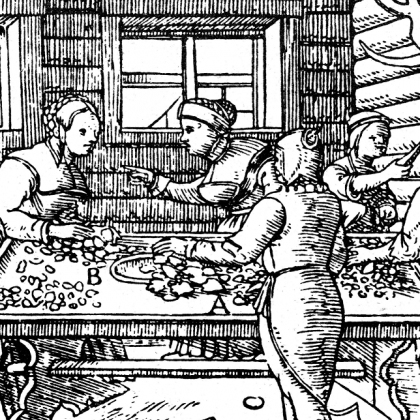Mining Shakespeare
Driving on Interstate 90 across the North American West, it’s possible, and encouraged, to travel fast. The speed limit is over 120 kph, but the wide open expanses of the state of Montana do not blur at such a pace, where the horizon forever recedes behind a seemingly unspoiled landscape. Westward beyond the Continental Divide, a town comes into view—a place called Butte, with a rich history that includes industrial-scale mineral extraction, conflicts over workers’ rights, and catastrophic environmental disasters. At the same time, Butte’s modern story highlights an indomitable commitment to restoration.
Butte’s raison d’être used to be mineral extraction, especially for copper, which began in the 1890s and peaked in the 1960s. Mining headframes still dot the terrain, and a huge M sculpted from local rocks marks a hillside where the school of mines is situated. The most striking, and disturbing, feature of Butte is the Berkeley Pit—a gigantic chasm filled with toxic water that is the legacy of open-pit mining and has resulted in the largest Superfund cleanup site in the United States. Butte’s economy collapsed several decades ago and its population has significantly decreased, yet it remains a fascinating place not only because of its history, but also because of its thriving cultural scene.
As a resident of Montana, I find myself drawn to Butte’s story, thus I have sought ways to speak about its past and potential futures. Like many others, I believe in the efficacy of Shakespearean texts for negotiating myriad issues facing us today, and my foremost interest is the environment. The excavation of a Shakespearean text to speak about the excavation of the earth in Montana creates an evocative synergy for dramatic adaptation. My aims are rooted in the practice of ‘ecodramaturgy’, an important ethical movement toward a more environmentally conscious theatrical practice. Ecodramaturgy ‘puts ecological reciprocity at the centre of its theatrical and thematic intent,’ thereby seeking ‘to break down binaries between nature and culture, hope and despair, the individual and the community.’[1]
In order to reflect upon Butte’s history of mineral extraction, societal collapse, and environmental damage, I adapted a play called Timon of Athens, which Shakespeare wrote with his fellow playwright Thomas Middleton. The adaptation, retitled Timon of Anaconda (the latter term was the name of the corporation that controlled Butte’s mining), served to highlight the story of Butte, especially from an ecological angle. The seventeenth-century satirical drama provided the words, ideas, and images around which the adaptation took shape. It was ultimately a natural fit to use this source to narrate the folly of the rampant capitalist hunger to dig in the earth for mineral resources without taking measure of the damage that this causes to both human and nonhuman life forms.
Timon of Anaconda’s outdoor, site-specific staging locations immersed audiences in the post-industrial realities of Montana towns. In one location the audience sat in the shadow of giant, defunct grain silos, and in the other in a park that had once served as a mining foreman’s home, overlooking Butte’s headframes and the Berkeley Pit. The resulting performances and discussions surrounding them encouraged new perspectives on persistent environmental concerns, thus fostering a way to talk about reclamation—both of the poisoned land and of the community in Butte.
My article ‘Ecological Adaptation in Montana: Timon of Athens to Timon of Anaconda’ (open access in the current issue of Cambridge journal New theatre Quarterly) narrates the process of adaptation and performance that I have been outlining above. The project reminded us all that creative adaptations of classical texts are most effective when they are tied to an evocative location that can help people grapple with the ‘where are we?’ foregrounded by ecodamaturgy.
Collective storytelling is a key component of any restoration for ecosystems, including our own important, and fraught, place within them. Providing a place for such historical tellings and retellings allows us to slow down, considering not just the expanse of space and the daunting scale of the problems, but also the generative lessons that can be gleaned from the local.
[1] Theresa J. May, in Readings in Performance and Ecology, ed. Wendy Arons and Theresa J. May (New York: Palgrave Macmillan, 2012), p. 4 and Kristin Idaszak, ‘Ecodramaturgy,’ www.kristinidaszak.com/ecodramaturgy.
Photo credit: Kevin Brustuen. Featured actors: Timon (Mark Kuntz) with Alcibiades (Keegan Grady.
Gretchen E. Minton is Professor of English at Montana State University, Bozeman. She has edited several early modern plays, including Timon of Athens, Troilus and Cressida, Twelfth Night, and The Revenger’s Tragedy. Her recent work as a scholar focuses on ecological approaches to and adaptations of early modern texts. She is the dramaturg for Montana Shakespeare in the Parks and Bozeman Actors Theatre, and the co-founder of Montana InSite Theatre (montanainsitetheatre.org). Minton’s directorial projects include A Doll’s House (2019), Timon of Anaconda (2019-20), “Shakespeare’s Walking Story” (2020), and “Sonnets in the Snow” (2021). gretchenminton.com.






